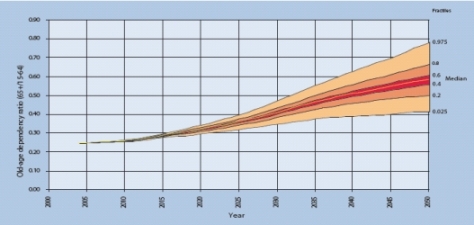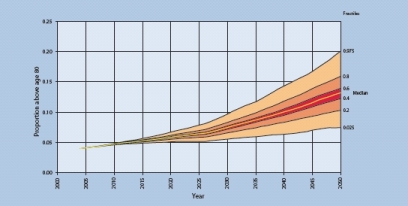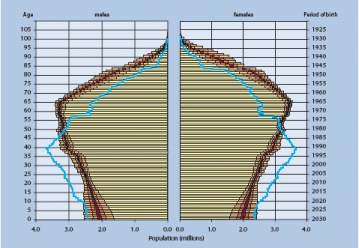Range of Likely Future Trends in the EU-25
The future trends of the three components shaping the pattern of population ageing in Europe (fertility, mortality and migration) are uncertain within plausible ranges. Recently, methods of probabilistic population projections have been developed to describe these uncertainty ranges in an explicit and quantitative way.
FOR DETAILED INFORMATION SEE
European Demogaphic Research Report 2006 No. 1
Figure 1 shows the future trend in the old-age dependency ratio for all 25 EU member countries taken together, with the orange area referring to the 95 per cent uncertainty range and the red area to the trend considered most likely.

This indicator currently stands at 0.25 which means that there are four people in the age group 15–64 (considered as the potential working age) for each person age 65 or older. As the figure shows, this ratio is bound to increase significantly over the coming decades and there is little uncertainty about the trend because most of this increase is already pre-programmed in today’s age structure. There is an 80 per cent chance that the ratio will more than double by 2050, which implies less than two persons of working age per person above age 65. And at the high end there is about a 20 per cent chance that there will only be three people of working age for any two persons above age 65. Since not everybody between age 15 and 64 will be actually working—because of education, parental leave, unemployment, early retirement or other reasons—the actual ratio of contributors to beneficiaries of the pension system may even be less favourable. While future trends in fertility, mortality and migration can only marginally alter this pervasive population ageing, the actual ratio of workers to pensioners can also be influenced by policies affecting labour force participation rates and the retirement age.
There is significantly more demographic uncertainty as to the future trend in the proportion of the population above age 80, as can be seen in Figure 2:

At the moment only 4 per cent of the population are of this advanced age. Over the next 20 years this proportion might well increase to about 6 to 7 per cent, but then the increase accelerates due to the strong baby boom cohorts gradually entering this age group. At the same time, the uncertainty range rises considerably. This is a consequence of the high uncertainty about the path that old-age mortality will take in the future, reflecting the controversy on longevity among scientists: some think that the recent gains in life expectancy may even accelerate in the future, while others suppose they will diminish. As a consequence, the 95 per cent interval for 2050 ranges from a low 7 per cent to a population in which one out of five persons is above age 80.
Figure 3 shows the probabilistic age pyramid for 2030 which clearly illustrates that the uncertainty differs by age, with the highest uncertainty about the future number of children and the lowest one for the cohorts born around 1970 which are beyond their prime migration age but not yet effected by the uncertainty about future old-age mortality.
